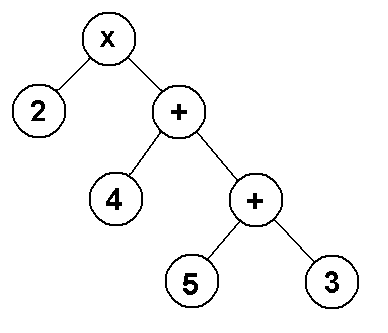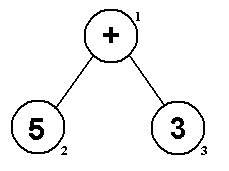By now, you should see a pattern. The last representation is postfix,
and we will use a post-order traversal to obtain it. Since in postfix
the operator comes after its two operands, will recursively print the left
and right subtrees before we print out the data at the current node.
Try to think about a way to traverse a tree and visit its nodes
in level order. In other words print the root, then everything
at level 2 (children of the root), then everything at level 3 (children
of level 2).
It is true that this is the natural result of a linear walk through the
vector representation of a tree. But, please don't approach the problem
that way. Try to find an algorithmic solution with the same flavor
as the traversals we covered today -- one that would work somewhat
independent of the representation.
Let's observe that our goal can be accomplished if we "look one level
down the tree". In other words, the parent can see its children, but
the children, the siblings, can't see each other. Given this, it
is clear that the parent needs to drive the process.
So, here's what we are going to do. We are going to approch this
iteratively. We are going to maintain a queue of verticies, inserting
them by level, from left-to-right. So, when we visit a node, we will
enqueue its children.
We get things started by enqueuing the root. Once we've done that, we
enter our main work loop. Each iteration, we will dequeue a node --
the node that we are visiting. At this point, we will consider it
visited and print it out, or whatever. Then, we will enqueue its children.
By doing this, all nodes at level n are enqueued, and will be
processes, before any deeper node at level n + 1 or greater.
We continue this loop, until we've processed all of the nodes -- the
queue is empty.
The pseudocode below ignores some Java details for clarity, but should
communicate the algorithm well.
void levelOrder (BinaryTreeNode root)
{
if (root == null) // Problem case
return;
// Initialize the queue
Queue levelQueue = new Queue();
levelQueue.enqueue (root);
// Process nodes, until we've got them all
while (!levelQueue.isEmpty())
{
root = levelQueue.dequeue();
System.out.println (root.data());
if (root.left() != null)
levelQueue.enqueue(left);
if (root.right() != null)
levelQueue.enqueue(right);
}
}

